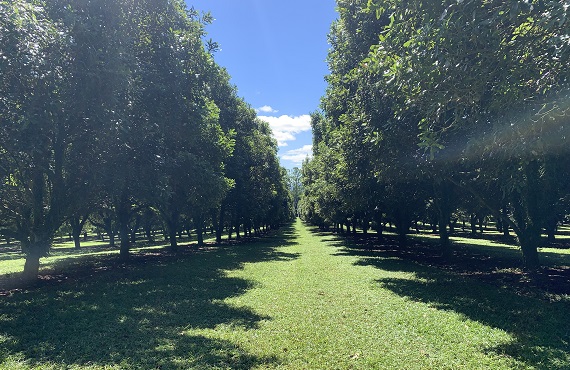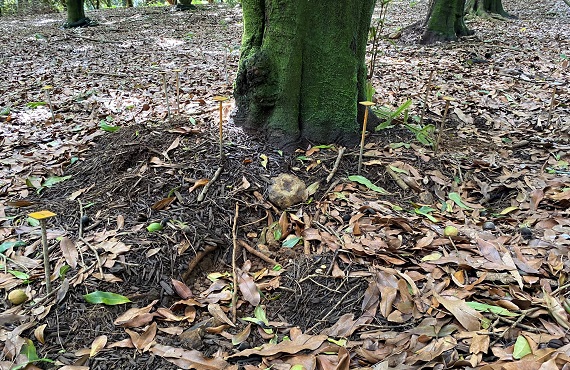
IOM Macadamia Resilience
Orchard resilience on show after torrential North Coast rain
Nothing to see here – and that’s the point!
Integrated Orchard Management (IOM) is proving the key to disaster resilience in the macadamia industry in an increasingly erratic climate.
The photo above was taken after torrential rain at McLeans Ridges, north west of Ballina on the NSW north coast. More than 500 mm fell over three days in February, followed by a further 650 mm over four days in late March.
Despite the intense rainfall, run-off water stayed clean due to the 100 percent living groundcover on the orchard floor that protected the underlying soil.
Craig Parrish from Roseville Macadamias is currently managing this 25 year old orchard utilising IOM techniques.
The trees are widely spaced to allow plenty of light to reach the orchard flood, promoting healthy grass growth between tree rows. Craig also adds mulch under the trees and actively cultivates full ground cover.
In 2018 the site was mapped to identify where new drainage lines were needed to efficiently remove water from the orchard. IOM excavation and ground works were partly funded by the Clean Coastal Catchments erosion control incentives program.
Although IOM has proven successful in making the orchard resilient against recent extreme weather events, according to Craig Parrish, implementing IOM is not a one off job.
“The drains, and the orchard itself, require ongoing maintenance to keep the system efficiently directing excess water across the orchard floor, and to ensure that water flows out of the orchard at the other end in a clean state,” said Craig.
The IOM concept was developed by the NSW Department of Primary Industries (DPI) in collaboration with the Australian Macadamia Society, and has become increasingly popular amongst growers.
“Even with extreme rainfall, the grass successfully binds the soil and prevents erosion, stopping valuable top soil from being washed away,” explains NSW DPI Macadamia Development Officer Jeremy Bright.
“Obviously the greater the slope, the more essential it is to maintain living ground cover between the trees. We have many orchards in the northern rivers on steep slopes. Growers have found ways to promote living ground cover on strategic drainage lines to help direct excess water flows safely through the orchard.”
Mulch spread under macadamia trees also plays an important role in reducing erosion, protecting valuable feeder roots and preventing nutrient loss.
Following recent extreme weather events, NSW DPI Soil Scientist, Justine Cox, has been collecting data from a soil erosion trial on a farm at Brooklet, to examine the effectiveness of various types of mulch applied to trees.
Even after more than 1300 mm of rainfall (over two events) Justine found both woodchip and ground mulch have remained largely intact.
“The size and the shape of the stringy ground mulch allows heavy rainfall to flow through the mulch, and as it has been in place for two years now at the trial site, surface roots and fungi have helped to keep the mulch attached to the soil,” said Justine.
She found that the mulch only moved in areas where water flow was concentrated on long downhill slopes.
The increase in the frequency of natural disasters occurring on the NSW north coast, means that this type of management, and the research and development that underpins it, will become more and more important.
Both Jeremy Bright and Justine Cox are part of the Clean Coastal Catchments project delivered by NSW DPI and funded by the NSW Marine Estate Management Strategy.
The Clean Coastal Catchments project works with growers to keep sediment and nutrients on farm and out of coastal waterways while supporting profitable and sustainable agriculture.



